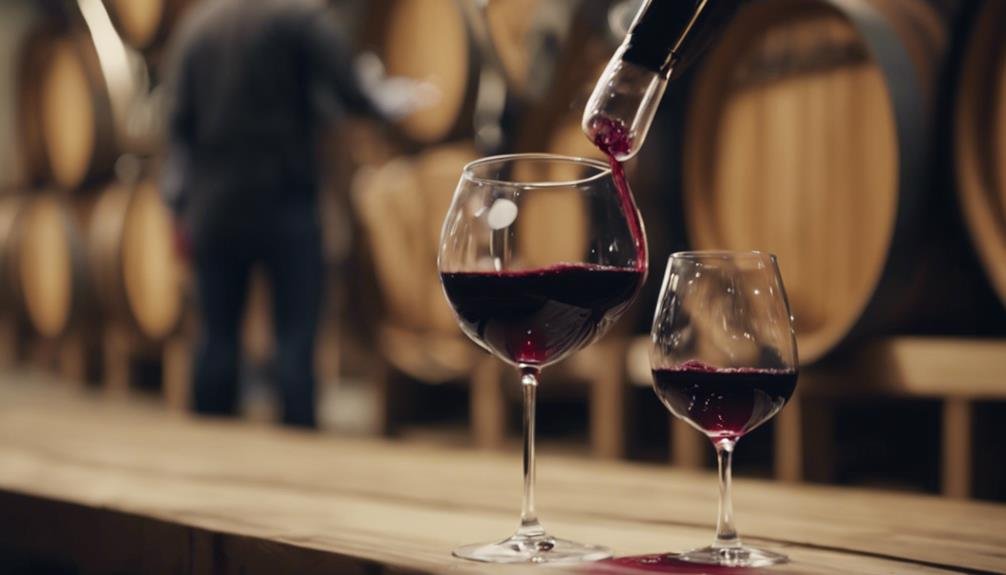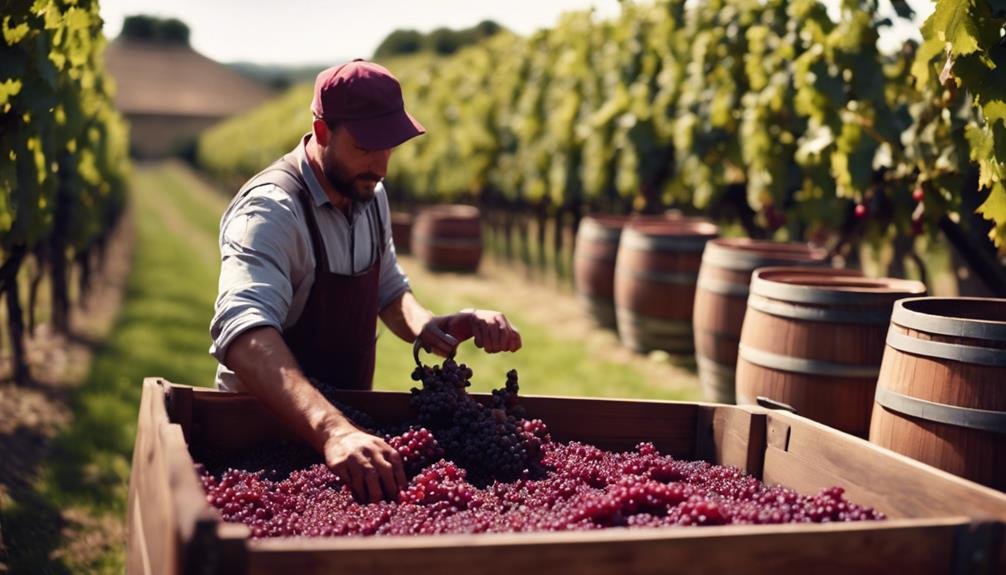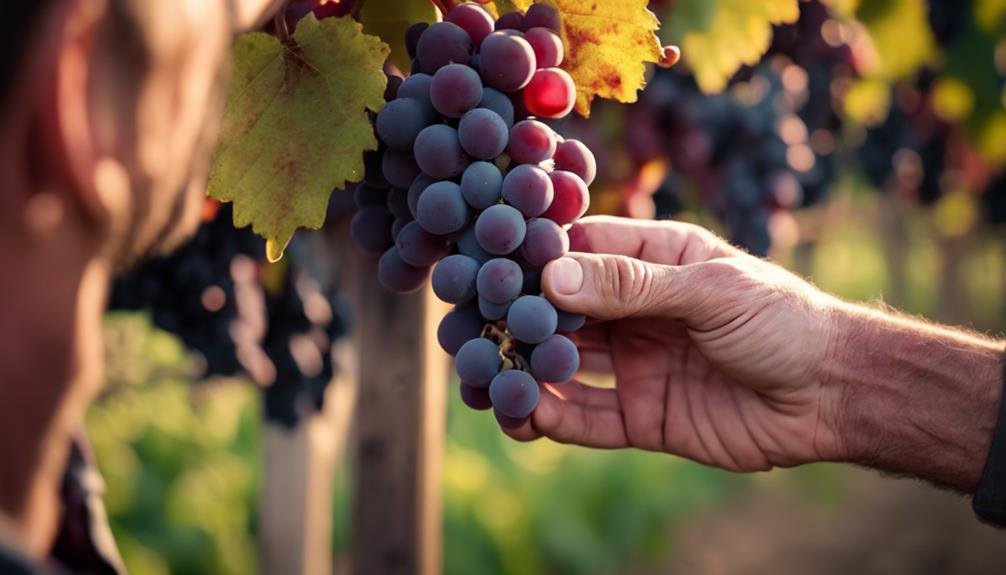Uncover the intricate world of red wine production, starting with grape harvesting where black wine grapes are carefully selected. Stem removal decisions influence tannin levels, essential for flavor balance. Fermentation sees yeasts transforming sugars into alcohol, while techniques like pumpovers extract flavors. Aging in oak barrels enhances complexity. Blending different grapes shapes the final flavor, with innovations in bottling technology maintaining quality. Crushing aids color extraction, setting the stage for successful winemaking. Additional juice extraction during pressing, careful barrel aging, and precise bottling contribute to the nuanced taste profile. Learn more about the meticulous steps that craft your favorite red wines.
Grape Harvesting and Preparation Techniques
Black wine grapes are meticulously harvested and prepared for fermentation in the production of red wine. This process involves deciding whether to remove stems before fermentation to control tannin levels and guarantee a balanced flavor profile.
Additionally, sulfur dioxide is commonly used on the grapes to prevent spoilage and maintain the quality of the wine. This step is vital in safeguarding the grapes from unwanted microbial activity that could lead to off-flavors in the final product.
Wine Fermentation and Aging Methods
Utilizing a meticulous approach to fermentation and aging techniques is essential in the production of high-quality red wines. During fermentation, yeasts play a significant role in converting grape sugars into alcohol. Winemakers can choose between commercial or natural yeasts to initiate this process.
Techniques such as pumpovers and punch downs are commonly employed to guarantee proper extraction of flavors and colors during fermentation. Additionally, many red wines undergo malolactic fermentation to achieve a smoother taste profile.
Aging red wines in oak barrels is a traditional method that imparts unique flavors and textures to the final product. This aging process is critical for enhancing the complexity and character of the wine.
Bottle aging further refines the wine's quality, resulting in a well-rounded and harmonious flavor profile.
Wine Blending and Bottling Processes

After meticulously fermenting and aging red wines to perfection, winemakers proceed to the meticulous process of blending grape varieties and bottling the final product to guarantee a harmonious and flavorful outcome.
Blending strategies play an essential role in achieving the desired flavor profile, with winemakers carefully combining different grape varieties or barrels to create a balanced and complex wine. Aging the blended wine further enhances its flavors and textures, ensuring a high-quality end product.
When it comes to bottling, innovations in technology have improved the process, allowing for minimal oxygen exposure and precise sulfur dioxide addition to maintain the wine's integrity. Quality control measures, such as fining and filtering, are employed to reduce the risk of spoilage, ultimately resulting in a premium bottled red wine ready for enjoyment.
Grape Harvesting and Crushing Details
The initial important step in red wine production involves the meticulous process of harvesting and crushing grapes to extract the juice essential for fermentation. Grape ripeness is essential, ensuring ideal sugar levels and flavors. When harvesting, deciding on stem removal is crucial to prevent bitter flavors in the wine.
Grapes can be harvested by hand or machine, with timing playing a significant role in the final wine style. Crushing the grapes releases the juice needed for fermentation, and this can be done either mechanically or manually. The crushing process breaks the grape skins, aiding in color extraction, a critical step in red wine production.
Attention to detail during harvesting and crushing sets the foundation for a successful winemaking process.
Pressing, Aging, and Bottling Stages

An essential stage in red wine production involves pressing the fermented grapes to extract additional juice for further processing and development.
After pressing, the wine enters the aging process, where it matures in carefully selected barrels to enhance flavor development. Barrel selection is vital as it imparts unique characteristics to the wine, influencing its final taste profile.
During this stage, the wine undergoes chemical changes that contribute to its complexity and depth.
Once the aging process is complete, the wine is bottled with precision, ensuring proper sealing and labeling to maintain its quality. Understanding the significance of pressing, aging, and bottling stages enhances one's appreciation for the intricate process of red wine production.
Special wines may continue aging in the winemaker's cellar for reserve bottlings, showcasing the artistry behind each bottle.
Frequently Asked Questions
How Does the Altitude of the Vineyard Affect the Flavor of Red Wine?
The altitude of a vineyard influences red wine flavor through cooler temperatures, affecting grape acidity and aromas. Higher altitudes may offer more sun exposure, impacting tannin development. Soil composition and microclimate unique to each altitude contribute to a vineyard's terroir.
Can the Use of Concrete Tanks Instead of Oak Barrels Impact Wine Taste?
The use of concrete tanks instead of oak barrels in the fermentation process can impact wine taste by offering a neutral environment that highlights grape flavors. This alternative aging method can enhance fruit-forward flavor profiles, providing a unique taste comparison to traditional oak barrel aging.
What Role Do Vineyard Pests Play in Red Wine Production?
Pest management is essential in maintaining vineyard health. By promoting natural predators and adopting sustainable practices, vineyards can reduce reliance on chemicals. This approach not only safeguards grape quality but also supports environmental balance.
How Do Environmental Factors Like Climate Change Influence Grape Quality?
Environmental factors, including climate change, greatly influence grape quality in red wine production. Soil quality and irrigation techniques play a vital role in grape development, impacting flavor profiles and overall wine characteristics, underscoring the importance of sustainable viticulture practices.
Are There Differences in Red Wine Production Between Old and New World Regions?
Differences in red wine production between old and new world regions stem from traditional techniques versus modern methods, with terroir playing a pivotal role. Old world regions emphasize heritage practices, while new world regions often innovate with technology to achieve distinct wine styles.
Conclusion
To sum up, the intricate process of red wine production is a harmonious symphony of art and science, where every step contributes to the creation of a masterpiece in a bottle.
The blending of flavors, the aging in oak barrels, and the meticulous attention to detail make red wine production a truly remarkable feat of craftsmanship.
It is a journey filled with passion, precision, and a touch of magic that captivates the senses and delights the palate.
